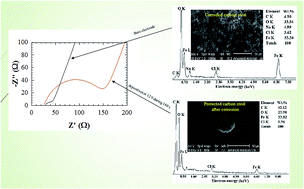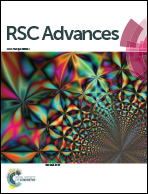Electrochemical and surface evaluation of the anti-corrosion properties of reduced graphene oxide†
Abstract
Herein, reduced graphene oxide nanosheets (RGON) were electrochemically grown onto a carbon steel alloy from graphene oxide (GO). The produced RGON was characterized using FT-IR, Raman, XRD, SEM and TEM techniques. Then, the anti-corrosion performance of the RGON-deposited layers was evaluated by weight loss and electrochemical methods such as open circuit potential (OCP), potentiodynamic polarization and electrochemical impedance spectroscopy (EIS) in NaCl 3.5%. Covering the surface with RGON led to a negative shift in the corrosion potential (Ecorr) and a decrease in the slope of the cathodic (βc) and anodic (βa) reactions, in which both demonstrate that the RGON can hinder the corrosion reaction. Parameters affecting film formation and consequently anti-corrosion performance, such as applied voltage and deposition time, were optimized. After applying 12 V during 180 s, the formed RGON layer on carbon steel showed the lowest corrosion current density (Jcorr) and corrosion rate (CR), and the highest charge transfer resistance (Rct). Finally, the morphology of the uncovered surface and that covered by RGON after 72 h immersion in NaCl 3.5%, was studied using SEM and EDXA techniques. The observed results are presented and discussed here.


 Please wait while we load your content...
Please wait while we load your content...